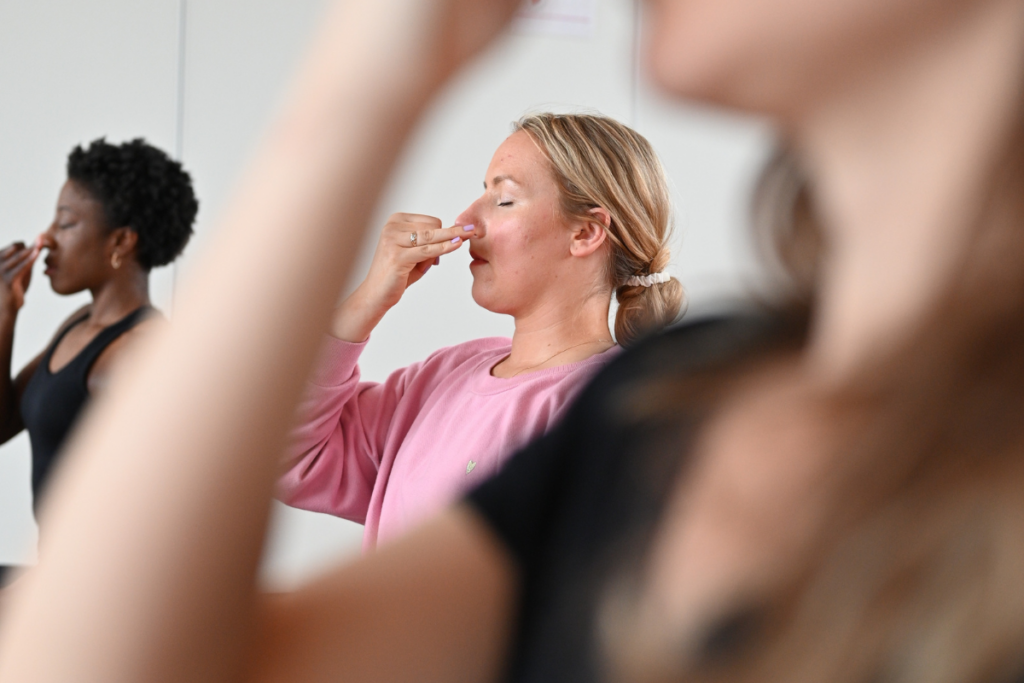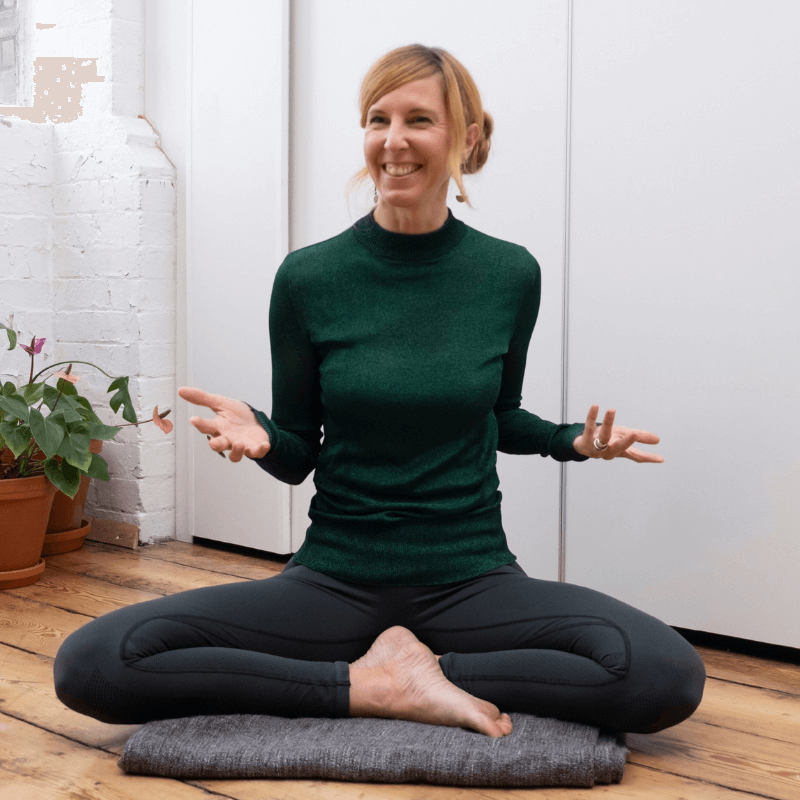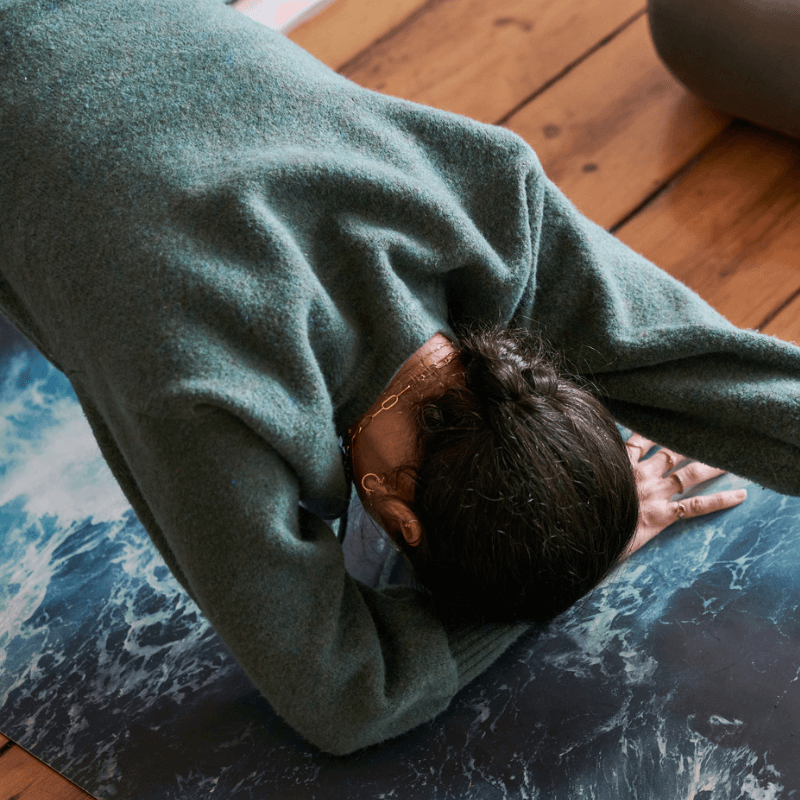
Cognitive Behavioural Psychotherapist & mindfulness teacher, Alice Leslie explores how yoga and meditation can help with mental health.
For the past year I’ve been working with Yogarise as a Cognitive Behavioural Psychotherapist and mindfulness teacher, offering psychological support to staff and clients with weekly community mindfulness classes. Meanwhile yoga got me through a personally challenging year, alongside therapy, friends and family, attending to joy and all the other basics. Heartfelt gratitude for my health, peace, warmth, food and water, infrastructure and all the privileges that afford me a comfortable modern life, albeit not without suffering. I’m only human.
“I am passionate about the benefits of movement and meditation for good mental health.”
We know each are as effective as antidepressants in treating a wide variety of mental health struggles. From stress, low mood, anxiety, panic and depression, to sleep difficulties and addiction. Meditation is known to help us respond more kindly to the inevitable fluctuations in mood, helping us be with ourselves and our difficulties rather than bracing against them. There’s a paradox here; we’re invited to soften and allow things to be as they are. By doing so we notice that things are changing all the time. If we can come up close to our difficulties and feel them in the body – be it pain, stress, a knot in the tummy or a feeling of dread in the chest – allowing it to be there and exploring it with curiosity is more likely to help it pass or dissipate naturally.
We have to accept our struggles with kindness in order to be able to make wise choices about how to look after ourselves. There is no therapeutic approach where a therapist is encouraged to be harsh, critical or demeaning to a patient. We would do well to remember this when we’re approaching our own difficulties. When we ruminate or worry we are not being productive, we are adding layers of difficulty to our raw experience. You can’t think your way out of a thinking problem. The metaphor of revving your tyres when you’re stuck in the mud rings true. Best to pause and find another way through. Help or rest may be the answer.

Yoga is an ancient and well-rounded system. A moving meditation offering us the benefits of both exercise and meditation. What a package! The endorphins, changed mental state and uplift of exercise combined with the focus and the soothing effects of meditation result in an increased ability to be with difficulty. I’m yet to find anything that rivals it per minute, and know from the experiences of my patients that this is not is not just me and my jangled nervous system. I’ve witnessed joyful transformations facilitated by establishing a regular yoga practice alongside talking therapy. Yoga moves things along when we feel stuck and makes us, both physically and psychologically, strong, supple and flexible.
“The hardest thing about meditation is making yourself do it.”
Another paradox is that often the more we would benefit from it, the harder it is to do. The busyness of life might be the cause of our pain, and also blocking of the cure. It’s no coincidence that we find it hard to sit with difficult feelings. An anxious mind is hard to sit with quietly. I believe that we can’t turn away from our feelings for long without them rebounding; that it’s best to accept what’s there and know that we’re feeling them anyway, trusting that making space for them reduces their impact. Guided meditation offers a method to touch in and feel with compassion, enhancing our chances of responding wisely. A sitting meditation can feel like agony. It’s an unhelpful myth that meditation is easy or relaxing. Often we are confronted with feelings we have deliberately suppressed. Relaxation is a very pleasant side effect that we can’t bank on or we will quickly abandon a regular practice, thinking that we’re doing it wrong if we’re not achieving this outcome. Where is my nirvana?? Aim lower – show up as you are and trust that it will do something over time. It’s more like composting a garden than an immediate psychological makeover. It will bear fruit over time.
Yoga is designed to prepare us for sitting meditation. Have you ever noticed yourself crying during hip or heart opening postures? Although I’m a psychotherapist, I think there are some things that need to be worked through the body as well as expressed and reasoned through verbally. Emotional tension is undoubtedly stored in the body and can be moved and manipulated through careful exercise and massage. WIth the body supple and exercised it is also easier to sit comfortably, with less aches and pains calling for attention, allowing a clearer place from which to observe the mind.
The endless separation of mind and body seems increasingly naive. They are one system; a healthy body and mind, yoked together is the aim. The body is likened to a wonky tripod that we’re born with, and the mind a misty telescope. Through exercise and care we can get the best out of our tripod, and through kindly regular mindful training we can gradually demist our telescope.

By imbuing our yoga practice with the fundamental attitudes of mindful attention – by which I mean curiosity, kindness, non judgment and non striving – we can get many of the benefits of a long seated meditation, in a way that can be more accessible. An invitation to link movement and breath is often enough to reduce unhelpful mental activity. A bit like rubbing your tummy and patting your head, competing processes make it harder to throw in extra mental activity. Less space for rumination and worry creates calm conditions to observe the mind. We’re invited to be and sense rather than think and do, which brings us into the present moment. The human mind lends itself to ruminating on the past or worrying about the future but benefits from being in the present moment. If we can drop the to-do list, critical thoughts and worry; we will feel better for it – fortified to approach our lives again. I liken this to when you leave your desk to go for a walk and a conundrum untangles itself, or the best ideas emerging when you’re singing in the shower. There’s a deeper level of wisdom than automatic reactive thought.
In CBT we question and challenge thoughts. In meditation we notice thoughts as thoughts (not facts) and come back to the body, the breath (or other focus), letting thoughts bubble up and pass without taking effort to suppress or investigate. Practicing a passive approach to our thoughts in meditation is radical and truly refreshing. Our true intentions and best ideas come from a quieter place. It is helpful to value rest, the idea that less could be more, and trust the emergence of instinct and wisdom when we create good conditions. Knowing that sitting quietly or practicing yoga helps us get more from ourselves over time. Even if it means time away from the desk and less time smashing out chores.
“Whether you are practicing a moving or sitting meditation, your practice is a great little petri dish – a mini world – in which you can notice your patterns and tendencies.”
In time leading to clarity and an ability to question unhelpful beliefs and assumptions, bringing in some flexibility and experimenting with doing things differently. When your mind wanders (that’s just what minds do) congratulate yourself for noticing, on a moment of awareness and for being awake. What are the qualities of the mind today? Sluggish, anxious, doubting? Notice with kindly curiosity and then make a choice to come back, gently but firmly, to the practice.
My gift to you – a free Mindfulness meditation
You can try a three step breathing space here!
We all have tendencies that flare up when we’re stressed, lonely or under pressure. It’s not if we’re going to struggle but how and when. It’s not undignified to struggle. We might be prone to worry, being hard on ourselves, comparing ourselves to others, getting avoidant or fearing judgment. Noticing when these well worn grooves become visible in our practice is helpful. Are we striving, competing, comparing? Avoiding showing up at all if we don’t think we can do things well enough? Ideally we would all be doing different things from one day to the next, and certainly from our neighbors on their mats. This would be a true indicator that we value our honest limits and are listening to feedback from our bodies. One day we might take a child’s pose during inversions, another we might throw in a quick headstand before savasana. What a great place to practice advocating for ourselves and being assertive, without consequence. Social anxiety be gone! I’m listening to my body. Honoring the wisdom of our bodies and being proud of listening to it, rather than hard on ourselves and following others. Your body will thank you and this promotes helpful attitudes and behaviors around assertiveness, valuing the self and not subjugating needs in the wider world.
I first started practicing yoga at University, 20 years ago. I cringe when I remember shuffling off during savasana, instead of lying still for a few minutes. I thought I was too busy but I was all kinds of anxious. I was feeding the busyness by scuttling off but relish the stillness now. Taking a few moments to imagine the body like a snow globe, all shaken up by movement – blood pulsing through hard working muscles. Feeling the heartbeat slowing and the effects of the movement as sensation in the body. This is valuable in a way that is hard to put into words. It’s best felt. They say that mindfulness is caught not taught.
I’d love to practice with you. I offer a Free Community Mindfulness Class at Yogarise, Peckham on Thursdays (term time only) from 1:30 – 2. Book here to join online or drop in and practice with us in studio. No experience necessary. Pairs very nicely with Annie’s 12:30- 1:15 Dynamic Pilates and En Root’s Thursday soup offering in the Yogarise cafe.
There are some guided meditations and blogs about mental health on my website. You’re welcome to contact me on alice@revivelondon.org.uk with any questions or to discuss working together. I offer free 15 minute telephone consultations for Yogarise clients and I’m at Yogarise every Thursday if you’d like to come and say hi.
You can find your nearest NHS therapy option here.
If you’re in urgent need of help and have concerns about whether you can keep yourself safe tell you GP and or visit A&E. The Samaritans offer an excellent confidential listening service: 116 123
Written by Alice Leslie.



